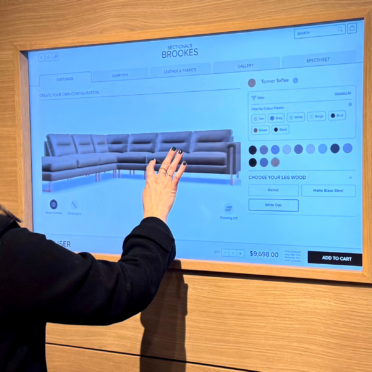Globally, the furnishings eCommerce industry generated $29 billion in 2022, and by 2030, the size of the market is forecasted to reach about $41 billion worldwide––a 41% growth rate.
As the furnishings industry recovers from and evolves through post-pandemic trends, new technological advancements continue to shape and be shaped by shifting consumer behaviors.
This article dives into 4 top trends for the Furnishings eCommerce industry to help your company stay ahead of the curve in 2024.
#1: The Expansion of Omni-channel Retail
3 years ago, worldwide lockdowns pushed brick-and-mortar stores to strengthen their online presence. In 2024, the reliability of physical stores is pushing even online brands to build outlets offline.
Not only does it give brands more touchpoints with consumers to attract more buyers, but the customer experience allowed by seamless online-to-offline connections is unparalleled and promotes brand loyalty. However, the space has become more competitive. Brands that are serious about capturing business need to build exceptional online and offline experiences to keep up with consumer expectations.
Palliser Furniture is one example of a brand that invested in an innovative in-store design kiosk and application for their retail partners to showcase their entire line and customize visually with all available options. Their newly launched website also allows consumers to build their product and then share it with a store near them to fulfill the order at the store.
#2: The Rise of Immersive Experiences

Advancements in 3D technology are revolutionizing the way that consumers interact with furnishings online and offline. From 3D technology enhancing virtual shopping experiences to the integration of augmented reality (AR) for visualizing products in real-life settings, brands are leveraging immersive technologies to captivate consumers. As younger generations dominate the market, the demand for seamless and engaging experiences continues to rise, driving innovation in this space.
In addition, as consumers gravitate towards mobile devices for browsing and shopping, offering mobile-first experiences on brand websites is also becoming imperative. From responsive design to streamlined checkout processes, prioritizing mobile accessibility enhances customer satisfaction and drives conversions. Upgrading your website with Adobe Commerce storefronts is a great way to wow such consumers.
Visit our 3D Product Configurator page to build more immersive product presentations on your website.
#3: Social Selling at an All-time High

Social selling has reached unprecedented levels–60% of consumers mentioned learning about new products through Instagram–prompting brands to invest in high-quality video content. From attracting customers through captivating social media campaigns to leveraging marketing automation for personalized interactions, brands are leveraging social platforms and forging strategic relationships with influencers, to guide consumers through every stage of the buyer’s journey.
Additionally, retail and wholesale websites nowadays cater to the full buyer journey, including integrating social media aggregators so that your prospects can see how your products can be styled, to making the actual purchase and aftercare and claims. For reference, check out Hubbardton Forge’s website featuring a social media aggregator that allows them to engage more deeply with the spaces consumers and designers are creating using their products.
#4: The Focus on Sustainability
Finally, as consumers become increasingly conscious of their environmental footprint, sustainability emerges as a pivotal trend in the furnishings industry. Brands are prioritizing eco-friendly materials, ethical sourcing practices, and responsible manufacturing processes to appeal to environmentally-conscious consumers. By aligning with sustainable values, businesses contribute to a greener future but also resonate with a growing segment of socially-aware shoppers.
Conclusion
In the ever-evolving landscape of furnishings e-commerce, adaptation is key to staying ahead of the curve. Businesses can position themselves for success in 2024 by embracing trends such as omnichannel integration, immersive experiences, social selling, and sustainability. As consumer preferences continue to evolve, agility and innovation will remain essential pillars for navigating the dynamic terrain of e-commerce.
Ready to future-proof your furniture eCommerce business? Contact Jola today and unlock a world of innovative solutions!









